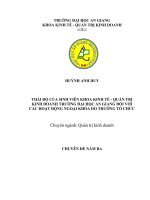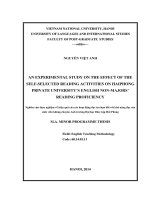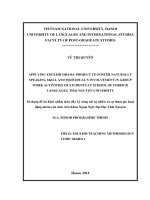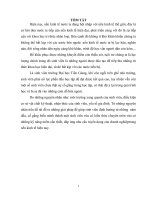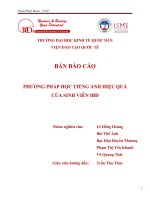- Trang chủ >>
- THPT Quốc Gia >>
- Sinh học
HIỆU QUẢ CỦA HOẠT ĐỘNG HỌC HỢP TÁC ĐỐI VỚI THÁI ĐỘ, NHẬN THỨC CỦA SINH VIÊN KHOA QUỐC TẾ, ĐẠI HỌC QUỐC GIA VỚI KĨ NĂNG VIẾT
Bạn đang xem bản rút gọn của tài liệu. Xem và tải ngay bản đầy đủ của tài liệu tại đây (497.44 KB, 8 trang )
<span class='text_page_counter'>(1)</span><div class='page_container' data-page=1>
<b>THE EFFECTS OF COOPERATIVE LEARNING ACTIVITIES </b>
<b>ON IMPROVING STUDENTS’ PERCEPTION AND ATTITUDES </b>
<b>TOWARDS WRITING SKILLS AT INTERNATIONAL SCHOOL, </b>
<b>VIETNAM NATIONAL UNIVERSITY HANOI</b>
<b>Tran Thi Lan Huong </b>
<i>VNU International School </i>
ABSTRACT
With the aim to explore the effectiveness of cooperative learning (CL) activities on improving
students’ perception and attitudes towards writing skills, the researcher employed two different
teaching methods to teach two groups in 10 weeks: CL for experimental group and traditional
method for control group. Traditional group learning method only puts students to sit and group
without further assistance and careful structure to make group work become teamwork; whereas
cooperative learning goes strictly with five elements including positive independence, individual
accountability, quality group processing, explicit teaching of small group skills and teaching of
social skills. A pre- and post- questionnaire were delivered to students at the beginning and the end
of the experiment and the data was analyzed to find out to what extend each method affected
students’ interest and perception about writing skill. Results from the analysis show that CL is an
intriguing and effective way for students to learn writing skills. Learning in groups is generally
more interesting and beneficial for their writing performance, especially for those steps like
brainstorming ideas or editing essays.
<i><b>Key words: Cooperative Learning; CL; learning in groups; writing skills; process writing; </b></i>
<i><b>perception; attitudes…. </b></i>
<i><b>Received: 10/4/2019; Revised: 27/5/2019; Approved: 31/5/2019 </b></i>
<b>HIỆU QUẢ CỦA HOẠT ĐỘNG HỌC HỢP TÁC ĐỐI VỚI THÁI ĐỘ, </b>
<b>NHẬN THỨC CỦA SINH VIÊN KHOA QUỐC TẾ, ĐẠI HỌC QUỐC GIA </b>
<b>VỚI KĨ NĂNG VIẾT </b>
<b>Trần Thị Lan Hương </b>
<i>Khoa Quốc tế - ĐH Quốc gia Hà Nội </i>
TĨM TẮT
Với mục đích tìm hiểu hiệu quả của việc sử dụng hoạt động học hợp tác, học nhóm để nâng cao
nhận thức cũng như thái độ của sinh viên đối với kĩ năng viết, tác giả đã sử dụng hai phương pháp
giảng dạy khác nhau cho hai nhóm sinh viên trong 10 tuần. Trước và sau khi tiến hành dạy thử
nghiệm, tác giả phát ra hai bảng câu hỏi để phân tích tìm hiểu hiệu quả của từng phương pháp đối
với nhận thức và thái độ của sinh viên đối với kĩ năng viết. Kết quả từ phân tích dữ liệu bảng hỏi
cho thấy phương pháp học hợp tác là một phương pháp thú vị và có ích cho kĩ năng viết của sinh
viên tại Khoa Quốc tế, Đại học Quốc gia Hà Nội. Phương pháp mới không chỉ cải thiện khả năng
động não lấy ý, chỉnh sửa bài viết của sinh viên mà còn làm tăng sự tự tin của sinh viên khi viết
tiếng Anh. Nghiên cứu đóng vai trị như một gợi ý để cải thiện hoạt động giảng dạy kĩ năng viết tại
Khoa cũng như là một nguồn thông tin tham khảo cho các giáo viên tiếng Anh ở các đơn vị khác
tham khảo.
<i><b>Từ khóa: học hợp tác; học nhóm; viết quá trình; thái độ; nhận thức; kĩ năng viết…. </b></i>
<i><b>Ngày nhận bài: 10/4/2019; Ngày hoàn thiện: 27/5/2019; Ngày duyệt đăng: 31/5/2019 </b></i>
<i>Email: </i>
</div>
<span class='text_page_counter'>(2)</span><div class='page_container' data-page=2>
<b>1. Introduction </b>
While teaching English at VNUIS, the
researcher found that writing was the hardest
skill for students, consequently, most of
students were not actively involved in the
lessons. Besides, their learning outcomes for
this skill were very low. It has been widely
believed that there are some sound reasons to
take cooperative learning into
implementation. Firstly, the most obvious
benefit of CL for students falls into academic
achievement. Working in groups enables
learners to provide each other with
information, suggestions, reminders and
motivation [1]. They not only achieve better
results, develop their thinking and leadership
skills but also enjoy their learning with
positive views towards other learners, good
self-esteem and a sense of belonging to a
group. CL strategy was found to be useful for
both language education and other aspects
such as motivational and communicative
activities [2], good relationship with
participants and stress overcoming [1].
Moreover, in CL classrooms, lower students
learn much from strong partners because
when working individually they may get
stuck, but collaborating with better students
enable them to understand the materials
more easily [3].
In the second place, cooperative learning
betters students socially and emotionally. CL
helps learners to become better
communicators and listeners, cooperative
members as well as effective leader of a team.
Furthermore, CL is also considered an
effective remedy for educational problems by
not only helping to improve academic results
but also encouraging learners to become
involved in social and academic settings. It
also has good impact on the problem solving
ability of children [2]. Children of lower
ability who completed their work
collaboratively with peers of higher ability
had significant improvement in their
performance. In addition, learning
cooperatively enables learners to
communicate with each other, which gives
them opportunities to talk together about their
work socially and collaboratively [4].
Discussion with peers is also a good way to
make writing more meaningful and apparent
and helps learners to become able to read
their work critically.
</div>
<span class='text_page_counter'>(3)</span><div class='page_container' data-page=3>
the application of cooperative learning
activities in writing lessons brought about
desirable benefits to both teachers and
students. They boosted students’ interest to
learn and to work hard in writing lessons. The
findings demonstrated that CL activities are
not biased towards oral communication; it can
be some good to any of four language skills.
It was urgent that another teaching method
should be found and applied to improve the
situation of teaching writing at VNUIS and
after a thorough examination, cooperative
learning method was chosen to use.
<i><b>1.1 Cooperative Learning </b></i>
In language learning contexts, CL is defined
as within-class grouping of students usually
of differing level of foreign language
proficiency who learn to work together on
specific tasks for projects in such a way that
all students in the group benefit from the
interactive experience. Students work
together to maximize their own and each
other’s learning. According to Johnson and
Johnson (2005) [9], CL is a teaching strategy
in which small teams use a variety of learning
activities to improve their understanding of a
subject, each member is responsible for
learning and helping classmates until they all
understand and complete the assigned task.
<i><b>1.2 Five key elements of Cooperative </b></i>
<i><b>Learning </b></i>
<i>1.2.1. Positive interdependence </i>
According to Johnson, Johnson & Smith
(1991) [10], group members understand that
they need each other to fulfill the assigned
tasks so they will contribute to the learning of
group actively. This element is the heart of
CL because the nature of cooperative learning
is the improvement and maintenance of
positive interdependence among team
members. Students need to do activities in
which they learn to depend on each other as
they get help from one another. Instructors
may structure positive interdependence by
establishing mutual goals to maximize own
and each other’s productivity, giving joint
rewards, for example if all members achieve
above the criteria each will receive bonus
points, sharing resources with members’
different expertise and assigning roles of
summarizer, encourager or elaborator. As a
result, teamwork will help them learn
valuable skills which will benefit them
vocationally and socially.
<i>1.2.2. Face-to-face interaction </i>
Academic and language learning requires that
students have opportunities to understand
what they hear and read as well as express
themselves in meaningful tasks [11]. Students
are engaged in high level thinking skills such
as analyzing, explaining, synthesizing and
elaborating through cooperative learning.
These interactive experiences are extremely
valuable for students who are learning
English as a second language because they
naturally stimulate and develop the students’
cognitive, linguistic and social abilities. Thus,
students should be taught and reinforced
about the way to interact effectively with
others. They gradually get to know and trust
one another through teambuilding activities.
Accepting and supporting one another and
resolving conflicts constructively are other
useful skills students attain when doing CL
tasks. Also, teachers need to model positive
interpersonal skills, get students practice the
skills as well as encourage them to process
the effectiveness of their performance.
Focusing on social skill development will
increase student’s achievement and enhance
students’ employability, interpersonal
relationships and general psychological
health [9].
<i>1.2.3. Individual accountability </i>
</div>
<span class='text_page_counter'>(4)</span><div class='page_container' data-page=4>
cooperative learning groups is all students can
achieve higher academic results individually
than when they study alone. Consequently,
each student must be held individually
responsible and accountable for doing his or
her own share of the work and for learning
what has been aimed to be learned.
<i>1.2.4. Social skill </i>
Johnson, Johnson and Holubec (1993) [15]
points out those groups cannot function well
if students do not have and use the needed
social skills such as leadership,
decision-making, trust-building, communication, and
conflict-management skills. For the
cooperative learning environment and
precisely as academic skills and the learner
should utilize the skills they have learnt in
completing assigned activities. Stahl (1994)
[14] asserts that students are placed in groups
and expected to use appropriate social and
group skills does not mean students will use
automatically use these skills. In order to
work as a group, students need to learn to
cope with leadership, trust-building,
encouragement, compromise and clarifying.
Teachers need to describe expected behaviors
and attitudes as well as assign students roles
to make sure that consciously work on these
behaviors in their groups.
<i>1.2.5. Group processing </i>
Johnson, Johnson and Holubec (1993) [15]
also state that groups need specific time to
discuss how well they are achieving goals and
maintaining effective working relationship
among team members. Teachers need to
ensure there is some structure to the group
processing. This can be done by assigning
such tasks as follows. First, teachers list three
members that helped the group be successful.
Second, one action that could be added to
make the group even more successful
tomorrow should be mentioned. Teachers
need to monitor the groups and give feedback
on how well the group is working together to
the groups and the class as a whole.
<b>2. Research methods </b>
In order to investigate if cooperative learning
influences positively on students’ perception
and attitudes or not, a quasi-experimental
research design was applied in the present
study. The data from pre-and post-
questionnaire were quantitatively analyzed to
find out the answer.
In this study, the researcher chose one class
at random to be assigned to the experimental
group while another class made up the
control group. Each group consists of 18-19
students aged from 19-20. The two groups
have common features in terms of number,
age, English level and motivation to study.
These students also share characteristics with
other groups of General English Program at
<b>VNU-IS. </b>
During the experiment time, the students in
two groups received different treatment.
<i>The control group: The theory of cooperative </i>
learning was not taught and applied in this
class. 18 students in the control group were
taught about different genres of essay and
then asked to practise the stages of writing
individually in order to deal with the tasks
given by the teacher. After the time limit for
each stage was over, teachers had some
feedbacks on students’ products before they
continued with the next stage. They were also
allowed to ask the teacher any questions or
for any further information.
<i>The experimental group: The teacher put 19 </i>
students in groups of 3/4 members and made
them tackle a task collaboratively. They were
also taught about different genres of essays
and then asked to work in groups to practise
the stages of writing in order to deal with the
tasks assigned by the teacher. Students had to
finish each stage in the time limit given by the
teacher.
</div>
<span class='text_page_counter'>(5)</span><div class='page_container' data-page=5>
appropriate and relevant vocabulary that
could be used in the task. They could use
dictionaries to check or find more suitable
vocabulary. They together organized ideas
and produced the outline for the essay.
Stage 2: Drafting and writing stage - 30
minutes: During this stage, each student wrote
their own essay without asking other
members for help. They were aware that in
this stage, they should use the ideas and
vocabulary they had prepared in pre-writing
stage without paying any attention to
grammatical and spelling mistakes.
Stage 3: Revising stage - 20 minutes: The
students revised their essays collaboratively.
Each student put their essay in front of
everyone and starts to read and offer
comments. They were instructed that they
had to make sure that they used appropriate
vocabulary, rearranged any unclear
sentences and paragraphs. They should not
offer any comments on grammar and
spelling mistakes in this stage. After getting
feedbacks from peers, each student started
writing the second draft.
Stage 4: Editing stage - 20 minutes: Each
draft was put in the centre of the group and
students edited it collaboratively. They
checked for any linguistic mistakes and
accuracy including spelling, grammar and
punctuation. Correcting errors and mistakes is
the main priority in this stage.
<i><b>Questionnaire </b></i>
A questionnaire was distributed to both
groups at the beginning and the end of the
treatment to investigate students’ attitude
toward general writing and cooperative
learning in writing class. The questionnaire
consisted of 20 statements in which 10 first
statements were about general writing and the
other 10 statements were about cooperative
writing with a 5 point Likert scale (strongly
agree, agree, neutral, disagree and strongly
disagree). The questionnaire was adapted
from Al-Besher (2012) [6]. The Al-Besher’s
questionnaire was also used to examine the
difference in the attitudes and perception of
students towards writing skill and cooperative
<b>writing before and after the treatment. </b>
<i><b>Data analysis </b></i>
To investigate the effects of different methods
on students’ attitude towards writing skills
and cooperative writing, the results of pre-
and post-questionnaire filled by the both
groups were computed using paired samples
t-test.
<b>3. Results and discussion </b>
<i><b>3.1 Analysis of questionnaire about writing </b></i>
<i><b>skills in general </b></i>
With regard to questionnaire about writing
skills in general, the results shown in Table 1
indicate that the mean difference was 2.26,
which was significant (paired t test, t=2.42,
p=.026). Meanwhile, the mean difference
achieved by students of the control group was
1.2, which was not significant (t=2, p=.06).
This means that the responses of students in
the experimental group about writing skills in
general improved after the treatment while
those of students in the control group did not
change.
<i><b>Table 1. Comparing pre- and post- responses of 2 groups concerning writing skills in general </b></i>
<b>Statements about writing skills </b>
<b>in general </b> <b>Mean </b> <b>N </b> <b>SD </b>
<b>Mean </b>
<b>Difference </b> <b>t </b> <b>p </b>
Experiment Pre –questionnaire 31.52 19 3.11 2.26 2.42 .026
Post – questionnaire 33.78 19 1.47
Control Pre –questionnaire 29.88 18 1.96 1.2 2.0 .06
</div>
<span class='text_page_counter'>(6)</span><div class='page_container' data-page=6>
<i><b>Table 2. Comparing the pre- and post-responses within two groups concerning writing skills in general </b></i>
<b>Number </b> <b>Items </b>
<b>Experimental </b>
<b>group </b>
<b>Control </b>
<b>group </b>
<b>Mean </b>
<b>Difference </b> <b>p </b>
<b>Mean </b>
<b>Difference </b> <b>p </b>
1 The ease of writing skills .94 <b>.026 </b> .38 .06
2 The importance of writing skills <b>1.05 </b> <b>.002 </b> .38 .09
3 The interest of writing skills <b>1.26 </b> <b>.000 </b> .38 .09
4 Time spent to understand the topic .78 <b>.007 </b> <b>.77 </b> <b>.004 </b>
5 Making outlines before writing .42 .21 .72 <b>.038 </b>
6 Following the prepared outline when writing .68 <b>.008 </b> .27 .42
7 Correcting grammatical and spelling mistakes when writing .73 <b>.012 </b> .16 .38
8 Revising essays before finishing them .42 .11 <b>.77 </b> <b>.035 </b>
9 Editing vocabulary when finishing the essay <b>1.57 </b> <b>.000 </b> .66 <b>.035 </b>
10 Editing grammar when finishing the essay <b>1.73 </b> <b>.000 </b> .05 .77
<i><b>Table 3. Comparing pre- and post- responses of 2 groups concerning cooperative writing activities </b></i>
<b>Statements about cooperative </b>
<b>writing </b> <b>Mean N </b> <b>SD </b> <b>Mean Difference </b> <b>t </b> <b>p </b>
Experiment Pre –questionnaire 27.05 19 2.77 5.94 6.97 .000
Post – questionnaire 33.0 19 1.94
Control Pre –questionnaire 26.44 18 3.12 1.22 1.38 .183
Post – questionnaire 27.66 18 3.27
Table 2 presents that, in general, after the
experiment the attitudes of students in the
experimental group toward writing skills
improved remarkably in almost all aspects.
As shown in Table 2, they had the most
improvement in the attitudes toward editing
vocabulary and grammar before submitting
the essay and the importance and the interest
of writing skills with all mean differences
above 1.0. Likewise, there was an
improvement in the perception of students in
the control group about time spent for
understanding the topic before writing and
editing grammar before submitting with both
mean differences being .77. Especially, while
the attitudes of the experimental group toward
making outlines before writing and revising
the essay did not change, the control group
changed positively.
<i><b>3.2 </b></i> <i><b>Analysis </b></i> <i><b>of </b></i> <i><b>questionnaire </b></i> <i><b>about </b></i>
<i><b>cooperative writing </b></i>
With regard to questionnaire about
cooperative learning, the results indicated in
Table 3 means that although the responses of
students in the experimental group about
cooperative writing were not very good at the
beginning of the course, then they improved
after 10 weeks taking part in cooperative
learning classrooms. In the meanwhile, the
attitudes and perception of students in the
control group toward cooperative learning did
not change.
</div>
<span class='text_page_counter'>(7)</span><div class='page_container' data-page=7>
cooperative learning did not change much (p value for most items >0.05). At the beginning of the
course, they neither thought that learning in groups was an effective way to learn writing skills
nor wished to take part in cooperative learning (p value for item 1,10 > 0.05) and then after the
course, they kept their opinion unchanged although they agreed that learning in groups was
somehow good for editing essays, improving grammar and being more confidence in speaking
and writing (p value for item 4,6,7 <0.05).
<i><b>Table 4. Comparing the pre-test and post-responses within two groups concerning cooperative writing </b></i>
<b>Number </b> <b>Items </b>
<b>Experimental </b>
<b>group </b>
<b>Control </b>
<b>group </b>
<b>Mean </b>
<b>Difference </b> <b>p </b>
<b>Mean </b>
<b>Difference </b> <b>p </b>
1 The effectiveness of cooperative learning <b>1.89 </b> <b>.000 </b> .33 .11
2 Planning a topic with friends 1.0 <b>.005 </b> .05 .79
3 Revising an essay in groups 1.1 <b>.000 </b> .22 .21
4 Editing an essay in groups 1.47 <b>.000 </b> .61 <b>.012 </b>
5 Improvement in critical thinking thank to
cooperative learning .57 <b>.023 </b> .05 .85
6 Confidence in speaking and writing thank to
cooperative learning 1.15 <b>.000 </b> 1.05 <b>.002 </b>
7 Acquiring vocabulary better thank to cooperative
learning 1.15 <b>.001 </b> .5 <b>.04 </b>
8 Improving grammar thank to cooperative learning .84 <b>.014 </b> .27 .35
9 Getting higher scores in exams thank to cooperative
learning .89 <b>.006 </b> .27 .096
10 Preference to be involved in more cooperative
learning <b>1.94 </b> <b>.000 </b> .33 .13
<b>4. Conclusions and implications </b>
<i><b>4.1. Summary of the findings </b></i>
Concerning students’ attitudes toward
writing skills and cooperative writing, the
findings reveal that there were positive
changes in their attitudes. At the beginning
of the course, students did not think that
writing skills was important or interesting,
but after 10 week treatment, their opinion
changed for the better. At the end of the
course, students also had good perception
about the stages of writing. For example,
they were better aware of the priority of
each stage such as checking content of
writing during revising stage and checking
accuracy during editing stage. With regard
to cooperative writing, there was also
improvement in students’ attitudes after the
experiment. Most of students agreed that
cooperative learning was a good method to
learn writing skill and they preferred to be
involved in more cooperative learning in
the future.
<i><b>4.2. Recommendations </b></i>
The recommendations are combining
traditional approach and cooperative
approach, training students carefully about
cooperative learning, assigning groups of
different abilities and getting students to write
group’s diary. Since each approach has its
own strengths, teachers should combine
flexibly traditional and cooperative approach
basing on the specific teaching context to
have the most effectiveness.
</div>
<span class='text_page_counter'>(8)</span><div class='page_container' data-page=8>
instructed how to work collaboratively such
as how to brainstorm together, how to discuss
an essay, how to give comments and get
feedbacks.
However, in order to avoid the situation that
some students rely too much on other group’s
member, a group should have a diary in
which each member’s contribution in each
lesson is recorded. This is also a good way to
remind students of their responsibility when
doing group work.
<i><b>4.3. Limitations of the study </b></i>
The study is a relatively small scale one with
37 writing papers from two groups and 37
questionnaire respondents. This may be a
hindrance which prevents the researcher from
getting more precise findings related to
cooperative learning. Secondly, the
experiment was just carried out with
intermediate students, not students of all
levels, thus the results cannot be generalized
to all EFL students at VNU-IS.
REFERENCES
<i>[1]. Gillies, R.M. & Ashman, A.F., Cooperative </i>
<i>learning: the social and intellectual outcomes </i>
<i>of learning in groups, London: Routledge, </i>
2003.
<i>[2]. Graham, D., Cooperative learning methods </i>
<i>and middle school students, Unpublished PhD </i>
thesis, Capella University, 2005.
[3]. Gabriele, A.J., “The influence of
achievement goals on the constructive activity
of low achievers during collaborative problem
<i>solving”, British Journal of Educational </i>
<i>Psychology, 77 (1), 121-141, 2007. </i>
<i>[4]. Williams, J., Preparing to teach writing: </i>
<i>Research, theory and practice, 3rd Ed, </i>
Hillsdale, NJ: Lawrence Earlbaum Associates,
<i><b>2003. </b></i>
[5]. Ahangari, S. & Samadian, Z., “The Effect of
Cooperative Learning Activities on Writing
<i>Skills of Iranian EFL Learners”, Linguistics </i>
<i>and Literature Studies, 2 (4), 121 – 130, 2014. </i>
Doi: 10.13189/lls.2014.020403.
<i>[6]. Albesher, K.B., Developing the writing skills </i>
<i>of ESL students through the collaborative </i>
<i>learning strategy, 2012. Retrieved online </i>
September, 13th, 2014 from
/>
g_Writing_Skills_through_Cognitive_and_Co
mpensatory_Learning_Strategies.
<i>[7]. Grami, A., The effects of Intergrating Peer </i>
<i>Feedback into University-Level ESL Writing </i>
<i>Curriculum: A Comparative Study in a Saudi </i>
<i>Context, Doctoral dissertation, Newcastle </i>
University, 2010.
<i>[8]. Tran. T. H. L., The effects of cooperative </i>
<i>writing activities on improving </i>
<i>second-year-students at Tay Bac University, Unpublished </i>
MA Thesis. Vietnam National University,
2009.
[9]. Johnson, D. W., & Johnson, R., “New
Developments in Social Interdependence
Theory”, <i>Genetic, </i> <i>Social, </i> <i>& </i> <i>General </i>
<i>Psychology Monographs, 131 (4), </i>
pp.285-358, 2005.
[10]. Johnson, D. W., Johnson, R. T., & Smith, K.
<i>A., Cooperative Learning: Increasing College </i>
<i>Faculty </i> <i>Instructional </i> <i>Productivity. </i>
Washington, D.C: The George Washington
University, School of Education and Human
Development, 1991.
[11]. McGroarty, M., “Cooperative learning and
<i>second language acquisition”, Cooperative </i>
<i>learning: A response to linguistic and cultural </i>
<i>diversity, 2, (1), 19-46, 1993. </i>
<i>[12]. Jolliffe. W., Cooperative Learning in the </i>
<i>Classroom: Putting it into Practice, Thousand </i>
Oaks: Sage Publications, 2007.
<i>[13]. Stahl, R.I., The essential elements of </i>
<i>cooperative learning in the classroom, 1994. </i>
Retrieved online September 20th 2014 from
http:/www.ed.gov/pubs/OR/ConsumerGuides/
cooplear.html.
</div>
<!--links-->
Các môn thi Tốt Nghiệp của sinh viên Khoa Kinh Tế khóa 2006-2010 và hệ vừa học vừa làm khóa 2005-2010
- 2
- 506
- 0

